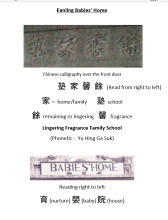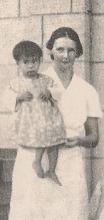Fanling Babies’ Home began in 1936 when missionary Miss Mildred Dibden returned to Hong Kong and cared for her first abandoned baby in Tsimshatsui. Mildred had previously worked with the BCMS, but after a serious illness, she went back to England, where she sought support to start a rescue mission for abandoned babies—mostly girls due to cultural reasons. Although missionary societies declined her request, encouragement from Dr and Mrs Lechmere Clift and their Emmanuel Church in Nathan Road, led her to act independently.
By 1940, Miss Dibden, her helpers, and 49 babies moved into Lai Yue Hing Tong (Hall) on Sha Tau Kok Road, Fanling, establishing the Fanling Babies' Home. The property featured a Western-style villa, two Chinese bungalows for staff, and well-kept gardens. Babies arrived via police, hospitals, and charities.
Despite looming war with Japan, Miss Dibden, joined by Australian nurse Ruth Little and colleague Iris Critchell, persevered through harsh conditions, though many infants tragically died from starvation or exposure.
After the war, China’s Children Fund purchased the property, allowing the home to continue. An Advisory Committee was formed in 1946 mentioned here; Ruth Little left and was replaced by Lucy Clay. In 1950, Miss Dibden departed again for health reasons, leaving Lucy Clay and China’s Children Fund in charge, later assisted by Miss Tsen.
In 1951, China’s Children Fund became the Christian Children’s Fund, focusing on Christian adoptions abroad. This reduced home numbers during the 1950s and 60s. A 1963 Prayer Letter reported 41 admissions that year, all placed in homes, with the largest group sent to England in December 1962.
By the early 1960s, the Fanling property deteriorated, prompting the relocation to Pinehill Babies’ Home in Taipo in 1966, managed by Lucy Clay until 1977.
Over the years, hundreds of mainly female babies were rescued thanks to the public, police, and hospitals.
Upon recovery, Mildred Dibden also founded the Shatin Babies' Home which originated in 1952.
Sources:
The Yip Family of Amah Rock by Jill Doggett.


Comments
Fanling Babies Home Christmas Party 1940
The armed forces personnel in Hong Kong gave valuable support to the Babies' Home. This snippet from the Fanling booklet gives a snapshot of the services in action. By this time there were about 50 babies/toddlers, the oldest aged four.
"December 25th. The party given by St. Andrew's Young People was just great. They have indeed sacrificed themselves for these little ones, and we did have such a good time. The Christmas tree was laden with toys and at the foot there was a wee pair of coloured shoes for each baby. After the tree came the tea party, where the Young People waited on the babies! It was most amusing to watch. Here a young Air Force lad was feeding a two year old with a sugar cake, and over there a "Government Servant" was supervising the serious business of eating a banana! Just near to me, where I sat watching these proceedings, was a table of four toddlers with a young Naval man in charge. His time was fully occupied, for jelly is slippery stuff for even the experienced to handle, and when we are only three years old, and it is our first attempt with jelly, it is rather difficult to keep it on a spoon! Down with the spoon, fingers are better! But no, the jelly squashes into bits, such a mess! To lick it up with the tongue is best! But now the young Naval man has something to say! "Here, you must use a spoon, what - come on, I'll help you."
Such sleepy little ones they were who at last climbed into the little blue cots, clasping their new toys. So sleepy! So full! So happy! Thank you God for the generous friends who love little children."
Fanling Home in 1964 Facebook Pics
Peter Brindley was an art teacher at St George's School HK, and he took these pictures of Fanling Babies' Home in 1964 showing students from the school visiting the Home as part of the Duke of Edinburgh Awards Scheme. I think the buildings are the bungalows and not the main building. The last two show the front of the house and the buildings over the road. Superintendent Lucy Clay is shown in 2 of the pics.
Hong Kong historians capture…
Hong Kong historians capture horrors of World War II in new website, with plenty more for heritage buffs, hikers too
Source: SCMP, 29th August 2021 by Rachel Yeo
1940 Fanling Babies' Home
A letter to the editor praising the work of the Fanling Babies' Home and pleading for continued support of the institution in the Hong Kong Sunday Herald 22 December 1940 at: https://archive.org/details/NPSH19401222/page/n7/mode/2up?q=dibden%2C+
3 in 1 bumper Sunday Herald item.
Thanks to Moddsey for the above Sunday Herald link. In the one piece we get updates on 3 different charities in Hong Kong in 1940. I have done a transcript and split the three items to their relevant pages.
December 22nd 1940 The Hong Kong Sunday Herald
HK Orphans of the Storm
Sir, through the agency of a mutual friend, I recently heard of the splendid work of three institutions in this Colony, which have never, to my knowledge, publicly appealed to the residents of Hong Kong for support.
I have felt constrained to make a few enquiries about these institutions, and the little information which I have been able to gather will probably be of interest to your readers. I might add that I am personally a total stranger to those in charge and the publicity I now give them was not solicited for in any way.
Babies’ Home Fanling
A few weeks ago, Miss Mildred Dibden appeared before the Public Tribunal on behalf of Miss Little with the request that she (Miss Little) might be permitted to enter the Colony to assist her in her work of running a foundling home. Miss Little is a trained nurse, but her application was turned down. Behind this incident is a story of faith and courage seldom met with nowadays.
Miss Dibden is a young Iady of faith and character. She returned to the Colony from England about four-and-a-half years ago with the avowed intention of founding a home for unwanted Chinese babies. The story of her difficulties and vicissitudes is a long one but against the advice and forebodings of her friends she persevered and to-day she is in sole charge of a large family of 45 children ranging from 4 and a 1/2 years to a few weeks old.
As can be imagined, the cost of clothing, feeding and caring (she has a few paid Chinese helpers) for these children must amount to a considerable sum monthly and Miss Dibden has no backing from any governing body in Hong Kong or elsewhere. Her friends have rallied round her, and she receives gifts of money, food and clothing, but without ever soliciting for her requirements, she relies on her God to supply her needs and He has not failed her.
What of the future? At this time when nobody wishes to add to his responsibilities or commitments, Miss Dibden still takes in poor unwanted children who come to her often deformed, diseased or discarded because of extreme poverty or superstitious ignorance on the part of the parents, She also plans to start a kindergarten for the older tots for whom her friends are now collecting stumps of pencils and scraps of paper. The Fraternity Bookroom, 216 Nathan Road, Kowloon, will, I understand, gladly receive any gifts for this deserving work.
Part 1 of 3, for part 2 see the BCMS Foundling Home and for part 3 see Florence Raetz, the Door of Hope, Taipo.
Traditional v simplified
The traditional character for the Ling of Fan Ling is 嶺, as opposed to the simplified 岭. The former might be more appropriate for a HK related topic (at least for the time being...). It's certainly the form most people will recognise from local signs etc